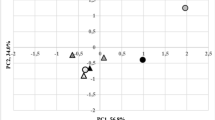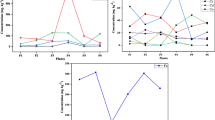Abstract
The k 0-INAA has been applied for determining nineteen elements in six medicinal plants used to cure various diseases in West Pokot, Kenya. It was observed that some elements are accumulated in excessive amount by the tested plants. Care has to be taken to control the daily dose of these herbs. Reference materials (IAEA-155 and IAEA-V-10) were analyzed simultaneously with the samples to evaluate the accuracy of the analysis protocol. It was found that the measured elemental concentrations were in a good agreement with the reported values with a maximum deviation of 20%.


Similar content being viewed by others
References
Abbott R (2014) Documenting traditional medical knowledge. http://www.wipo.int/export/sites/www/tk/en/resources/pdf/tk_toolkit_draft.pdf
Agrawal S (2009) Advances in medicinal plants. Oxford Book Company, Jaipur
WHO (2013) WHO traditional medicine strategy 2014-2023. WHO press Geneva, Switzerland
WHO (2003) Fact sheet no. 134: traditional medicine. http://www.who.int/mediacentre/factsheets/2003/fs134/en/
Ellen R (1996) Anthropological approaches to understanding the ethno-botanical knowledge of rainforest populations. In: Edwards DS, Booth WB, Choy SC (eds) Tropical rainforest research: current issues. Kluwer, Dordrecht, pp 457–465
National Council for Population and Development (NCPD) (2013) Kenya population situation analysis, government of Kenya and United Nations population fund (UNPFA). Nairobi, Kenya
Kenya service availability and readiness assessment mapping report, 2013
Maundu PM, Ngugi GW, Kabuye CHS (1999) Traditional food plants of Kenya. National Museums of Kenya, Nairobi
Soliman M, Mohamed N, Gaheen MA, Saad EA, Yousef SK, Sohsah MA (2011) Implementation of k0-standardization method of the INAA at ETRR-2 research reactor. J Radioanal Nucl Chem 287:629–634
Nangulu AK (2009) Food security and coping mechanisms in marginal areas; the case of West Pokot, Kenya 1920–1995 African studies centre; Leiden Netherlands
Ogolla JO (2015) Factors associated with home delivery in West Pokot County of Kenya; advances in public health. http://www.dx.doi.org/10.1155/2015/493184
Ngure PN (2014) Family planning in Kenya: An annual review of national and county family planning budgets for the year 2014/15; DSW (Deutsche Stiftung Weltbevoelkerung) Nairobi, Kenya
Almas K, AI-Lafi TR (1995) The natural toothbrush. Med Aromat Planl Ab 16(2):206–210
Jindal SK, Bhansali R, Satyavir R (1996) Salvadora tree—a potential source of non-edible oil. In: Proceedings of all India seminar on rabbi oil seed crop (Jodhpur, CAZRI)
Tolo FM, Rukunga GM, Muli FW, Njagi EN, Njue W, Kumon K, Mungai GM, Muthaura CN, Muli JM, Keter LK, Oishi E, Kofi-Tsekpo MW (2006) Anti-viral activity of the extracts of a Kenyan medicinal plant Carissa edulis against herpes simplex virus. J Ethnopharmacol 104:92–99
Woode E, Ansah C, Ainooson GK, Abotsi WM, Mensah AY, Duwiejua M (2007) Anti-inflammatory and antioxidant properties of the root extract of Carissa Edulis (Forsk.) Vahl (Apocynaceae). J Sci Technol 27(3):6–15
Bunalema L, Kirimuhuzya C, Tabuti JR, Waako P, Magadula JJ, Otieno N, Orodho JA, Okemo P (2011) The efficacy of the crude root bark extracts of Erythrina abyssinica on rifampicin resistant Mycobacterium tuberculosis. Afr Health Sci 11:587–593
Mbwambo ZH, Moshi MJ, Masimba PJ, Kapingu MC, Nondo RS (2007) Antimicrobial activity and brine shrimp toxicity of extracts of Terminalia brownii roots and stem. BMC Complement Altern Med 30:7–9
Kabbashi AS, Mohammed SA, Almagboul AZ, Ahmed IF (2015) Antimicrobial activity and cytotoxicity of ethanolic extract of Cyperus rotundus L. Am J Pharm Pharm Sci 2:1–13
Olila D, Olwa-Odyek Opuda-Asibo J (2001) Antibacterial and antifungal activities of extracts of Zanthoxylum chalybeum and Warburgia ugandensis, Ugandan medicinal plants. Afr Health Sci 1:66–72
O’Hara TM, Hanns C, Bratton G, Taylor T, Woshner VM (2006) Essential and non-essential elements in eight tissue types from subsistence hunted bowhead whale: nutritional and toxicological assessment. Int J Circumpolar Health 65:228–242
Kulkarni SD, Acharya R, Nair AGC, Rajurkar NS, Reddy AVR (2006) Evaluation of bioaccessibility of some essential elements from wheatgrass (Triticum aestivum L.) by in vitro digestion method. Food Chem 65:699–707
Yamashita CI, Saiki CI, Vasconcellos MB, Sertie JA (2005) Characterization of trace elements in Casearia medicinal plant by neutron activation analysis. Appl Radiat Isot 63:841–846
Serfor-Armah Y, Akaho EHK, Nyarko BJB, Kyere AWK, Oppon-Boachie K (2003) Application of instrumental neutron activation analysis to plant medicines in Ghana: a review. J Radioanal Nucl Chem 257:125–128
Choudhury RP, Kumar A, Garg AN (2006) Analysis of Indian mint (Mentha spicata) for essential, trace and toxic elements and its antioxidant behavior. J Pharm Biomed Anal 41:825–832
Singh V, Garg AN (2006) Availability of essential trace elements in Indian cereals, vegetables and spices using INAA and the contribution of spices to daily dietary intake. Food Chem 94:81–89
Acknowledgement
The authors wish to express my sincere gratitude to the International Atomic Agency for its financial support of the current work under the umbrella of AFRA project RAF9056—“Strengthening Education and Training in Radiation Safety and Sustaining Human Resources Development and Nuclear Knowledge Management (AFRA)”. Thanks also go to the Egyptian Atomic Energy Authority for preparation and analysis of the samples and for availing the reactor and spectroscopy equipment that were used in the irradiation and measurements.
Author information
Authors and Affiliations
Corresponding author
Rights and permissions
About this article
Cite this article
Benson, R.A., Mohamed, N.M.A., Soliman, M. et al. Application of k 0-INAA for the determination of essential and toxic elements in medicinal plants from West Pokot County, Kenya. J Radioanal Nucl Chem 314, 23–29 (2017). https://doi.org/10.1007/s10967-017-5370-3
Received:
Published:
Issue Date:
DOI: https://doi.org/10.1007/s10967-017-5370-3




